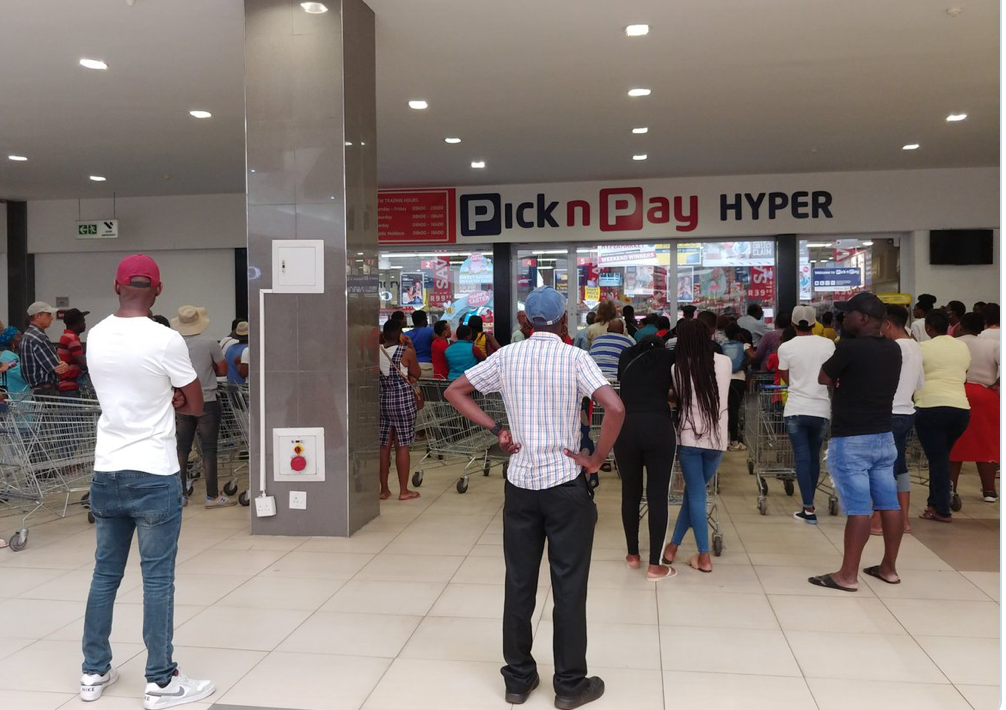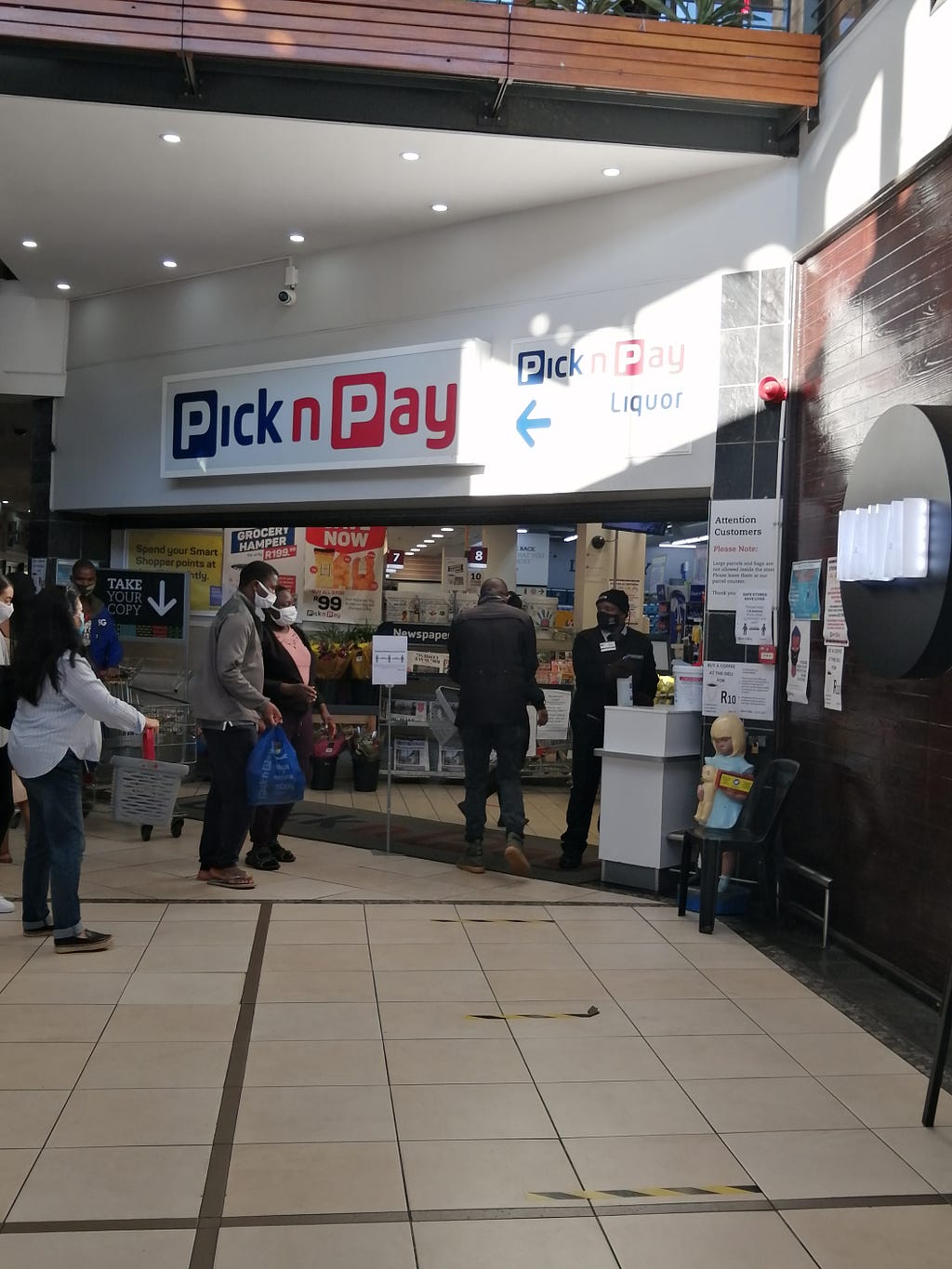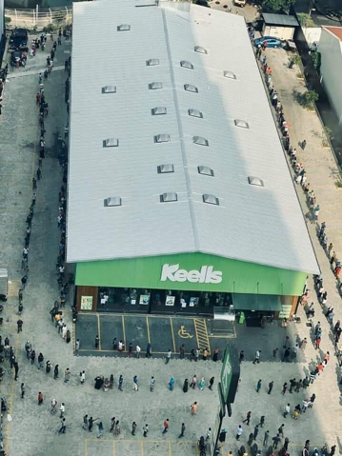Innovation is key to helping retailers and customers navigate through the new normal
by Talitha Loftus and Alex Barnes
As restrictions start to ease across the UK and crowds begin to gather, now more than ever businesses are relying on technology to support social distancing measures and ensure public spaces are kept safe.
As the COVID-19 pandemic sweeps across the world, we are seeing a new breed of services and new uses of technology emerge. A few weeks ago, the UK government announced a further reduction in social distancing measures enabling pubs, restaurants and hairdressers in England to reopen in early July. A positive step in the right direction, however, this decision doesn’t come without its challenges because as more doors begin to reopen the risk of infection becomes greater.
In a recent report conducted by RetailNext, figures showed a 14.9 percent increase in brick-and-mortar foot traffic for the month of June in comparison to May 2020. These results are encouraging and we look forward to seeing further growth overtime. However, one can’t become too comfortable when dealing with an unfamiliar virus such as COVID-19. Retailers need to be prepared and ensure they have the right tools, resources and strategies in place to prevent further spread.
“The current crisis should serve as a reminder to all retailers and consumer products and services companies that having a worst-case-scenario plan is an important part of critical strategic planning,” said Keith Jelinek, managing director in the retail practice at Berkeley Research Group, a global consulting firm.
Companies need to come together and look towards building innovative solutions to ensure public spaces are kept safe,“seeing the large numbers of people waiting in a queue to enter a shop has really surprised me and frightens me. We are seeing a resurgence of the virus and I’m very worried that we will see it here in the UK. In my local supermarket, the space between the aisles is tiny and hard to navigate. If you don’t use the one way system properly you will get too close to other people” said Adam from Oxford, a Crowdless customer.
To help build consumer confidence, brands need to pull together and ensure the right actions are being practiced to reduce the spread. Last month, RetailNext announced further enhancements to their occupancy solution and encouraged partnerships with companies such as Yoobic, sensalytics and more.
Without a doubt, innovation is the new necessity and apps like Crowdless optimise shopper experience by helping them to shop while respecting the social distance guidelines. Crowdless is a free app that offers shoppers supermarket crowd levels, in effect telling you how crowded stores are before you go. By using existing data sources, crowdsourced data and machine learning, Crowdless allows people to check in real-time whether a store is crowded before stepping foot in the door.

Apps such as this give consumers the confidence to re-enter stores with ease, “Our goal is to enable retailers and consumers to work together,” said Alex Barnes, co-founder at Crowdless. “Our users notify each other about how crowded stores are, which is a huge benefit to the community. This also supports the retailer, as it encourages users to discover new opportunities to shop at less crowded times”.
We are excited to see innovative apps such as Crowdless emerge in the market during these unpredicted times. If you would like to find out more about how the RetailNext Occupancy solution works, download the brief here. We also encourage you to download the free Crowdless app to know when it’s the perfect time to shop in-store!
Innovation is key to helping retailers and customers navigate through the new normal was originally published in Crowdless on Medium, where people are continuing the conversation by highlighting and responding to this story.
Community Ambassador Blog: Edilson - How a social distancing app helps people classified as “vulnerable” shop safely.
Edilson is a Community Ambassador for Crowdless in Brazil.

For me, one of the people classified as “vulnerable,” shopping in a crowded store brings an added risk of contracting the COVID-19 coronavirus.
My name is Edilson and I live in São Bernardo do Campo City, one of the largest cities in São Paulo State. If you know a bit about Brazil, you’ll be aware that the state of São Paulo is Brazil’s most economically productive and populous state. It accounts for more than one-fifth
of the national population. I work for a large company that sells technology appliances.
I was in a self-imposed lockdown even before the Brazilian government imposed the national lockdown. This is because I’m recovering from a disease so, when we were told to stay home it didn’t change my routine very much. In the beginning, I was worried about the whole situation but now I’m slowly adapting to this new way of living. Perhaps this is because I’m spending my time studying and preparing for the moment when I can get back to work. This makes me feel more relaxed about the lockdown rules.
The pandemic has affected my community in various ways. If you’re older than 60 and have caught the disease, you stay home. We’ve had a lot of difficulty with schools as they didn’t have time to prepare content for online home schooling and of course many people have become unemployed because of the pandemic. I’m afraid that it will take a lot of time to recover economically from this.
At the beginning of the lockdown in Brazil, I was surprised at how many people were going to supermarkets at the same time, even when there was such a great risk of becoming infected.
In the condominium where I live, neighbors have offered to shop for people who are vulnerable and who are at higher risk. Otherwise the alternatives to going to supermarkets are delivery services or asking help from volunteers who make purchases for people who are at risk. I’m very grateful for these kinds of gestures as they’re so important to save lives and reduce the risk of contracting the coronavirus.
Since I can’t leave the house due to my disease, my wife does our shopping and the shopping for our vulnerable neighbours. Being able to know the best time and place to shop — to go when it is less crowded makes the shopping much easier and less stressful for her. For example, we know that supermarkets will be crowded after pay day and on the day that people get their government benefits. But even if we don’t shop on those days, the capacity limit in our supermarkets is not always respected by managers, which creates queues. So, it is very important to know about the capacity before leaving home to shop. And to know this I looked for innovative solutions to solve this problem.
In search of information or an app that could help me, I found Crowdless, which offers such a solution. It’s really innovative since it allows people to interact by updating with real-time information on how crowded stores are.
I strongly recommend using the Crowdless app. Crowdless is part of the solution, because you participate and contribute to its accuracy and help people stay safe.
Download Crowdless on iOS or Android today: crowdlessapp.co/app.
Find out more crowdlessapp.co
Blog: How a social distancing app helps people classified as “vulnerable” shop safely. was originally published in Crowdless on Medium, where people are continuing the conversation by highlighting and responding to this story.
Community Ambassador Blog: Sandiswa Mapukata - Observing social distancing in South Africa; a privilege for the few
by: Sandiswa Mapukata, Campaigner for Social Justice and Sustainable Urban Development Researcher, Johannesburg, South Africa
@Sandiswa_17

I am a young South African working for an urban research institute based in Johannesburg. I am incredibly passionate about social justice and sustainable urban development.
In early March 2020, I received the wonderful news that I had received an offer for the LSE’s MPhil/PhD programme in Human Geography and Urban Studies. At that stage, I had not yet secured funding but I was not worried as I knew that I had more than enough time to secure some. Within three weeks, my plans for 2020 were upended as the first case of COVID-19 coronavirus was reported in South Africa. By the end of March 2020, South Africa’s president Cyril Ramaphosa had put in place a nationwide lockdown severely restricting movement and trade. This was initially meant to last for three weeks.

We are now more than two months into the lockdown with our government gradually easing us back into whatever normality is possible. I have accepted that I may have to defer my entry into the programme by another year which has been disappointing but understandable given the circumstances.
I think our government has done an amazing job but there have been some flaws with the drafting and implementation of some of the lockdown regulations. With the gradual reopening of the South African economy, there has been a worry around increased exposure to COVID-19. South Africa has yet to reach its peak of COVID-19 infections and related deaths. We are expected to reach the peak of our infections in late August/ early September. However, our government has largely succeeded in buying enough time to manage the anticipated caseload through our already strained healthcare system.
People who reside outside of middle-class areas will struggle to observe social distancing
Given South Africa’s socio-spatial history, people based in middle-class areas are better placed to practice social distancing than those who are not located in these areas. People based in townships and informal settlements (who constitute most of South Africa’s essential workers) find it more difficult to practice social distancing and often have to risk their health to take public transport to their jobs in supermarkets based in more privileged areas.
Shopping in the middle-class Capetonian suburb in which I am currently based, has been relatively easy. It has been fairly easy to practice social distancing whilst accessing essential items. The supermarkets in my area have been consistent with practicing social distancing. A set number of people are allowed into the supermarket and once that number has been exceeded then individuals have to stand outside in a queue. Once you get to the front of the queue, a security guard disinfects your trolley and offers you some hand sanitizer before you enter.
How Crowdless can help
I first heard about the Crowdless on Twitter. At the time, South Africa had just started its nationwide lockdown so I was really happy to hear about the existence of an app that would allow me to practice social distancing whilst getting essential goods.
Another reason why I was drawn to the app was because I was interested in how the app may assist people who live in marginalised areas to practice social distancing. It is important to note that with apartheid-era spatial design, individuals who don’t live in areas that were historically designated for white people are more likely to struggle with social distancing because their spaces were not designed to enable social distancing.

As the lockdown progressed, it became apparent that informal settlements and townships had become hotspots for police brutality under the guise of enforcing social distancing. It was with this in mind that I became interested in understanding how an app like Crowdless could be used by informal settlement and township residents to protect themselves and their family members whenever they had to get essential items from supermarkets.
This interest was the primary motivator behind my signing up to become a Crowdless Ambassador. Currently, I am busy engaging with various individuals who may be able to promote the use of the app on a wider scale. I do hope that my role will grow to one where I play a key role connecting key stakeholders with the Crowdless team to facilitate discussions around how the Crowdless app may be used as a tool for social justice in the South African context.
It will also be great to have other ambassadors on the ground promoting the app within several South African communities. An app like Crowdless will serve an important role in helping South Africans to reduce their exposure to COVID-19. One way the app will assist is through the feature which enables users to provide live updates of the busyness of supermarkets. Being able to choose favourite stores is also a great feature which will empower users to find information related to the busyness of the stores which they mostly buy from.
I have also had conversations with members of the team around allowing users to provide information on whether a store has been closed due to staff members testing positive for COVID-19. I think that this is a critical feature which will empower South Africans to choose which supermarkets to go to as they try to keep themselves.
Download Crowdless on iOS or Android today: crowdlessapp.co/app.
Blog: Observing social distancing in South Africa; a privilege for the few. was originally published in Crowdless on Medium, where people are continuing the conversation by highlighting and responding to this story.
Stay safe, save time and avoid crowds with Crowdless
Physical distancing may be the ‘new normal’
As countries around the world begin easing lockdown restrictions, we’re all faced with the problem of how to interact responsibly with one another.
Physical distancing is still necessary to help mitigate the spread of the COVID-19 coronavirus. We’re told by health authorities that this may be something we need to get used to — that it’s part of a ‘new normal’. So, as people are allowed to move around more freely, we need better awareness of where crowds and queues are so that we can plan our movements more safely.
Spending hours in a queue may not be your only option
Plus, who likes queues at supermarkets anyway? At Crowdless, we have a community of over 60,000 users from all over the world who’ve been writing in and sharing their horror stories of queuing at supermarkets.
Here’s a photo from one of our users, showing a crowd waiting to enter a supermarket in Colombo, Sri Lanka:

This was a problem even before this coronavirus pandemic struck. Prior to COVID-19, British people spent on average 5.5 hours a month waiting in lines[1]. Sure, the British love a good queue, but even they are now beginning to question the central role of queueing in British identity.[2] In fact, we surveyed our British users and only 15% of people say they would wait in a queue if they saw one.
With Crowdless, we’re providing a free tool to help you check how busy your local supermarkets are before you leave the house.
Get real-time information on how busy stores are so you can avoid crowds
With Crowdless, we’re providing a free tool to help you check how busy your local supermarkets are before you leave the house. This helps you choose a less busy time to visit or a less busy alternative. Not only can this help you save hours, it’s also a tool you can use to help you with social distancing and to stay safe.
Info from the community for the community
If there’s one thing we learned from lock-down, it’s that we’re all social creatures. It was difficult for many of us to go such a long period of time with minimal human interaction. Yet despite the barriers to physical interaction, we saw an upsurge in community sentiment. Communities were emerging virtually — through Zoom chats, WhatsApp groups, and online forums.
We heard stories from our volunteers about local communities creating WhatsApp groups to text each other information on how busy places are, so that vulnerable people could make better decisions about their movements. We heard stories from immuno-compromised people who relied on their friends and families to help them with the groceries.
We wanted to be a part of this community spirit, and to help magnify it. We know that the best information on how busy stores are comes directly from our community of users. They are the ones on the ground, experiencing things first-hand. We therefore launched our volunteer community ambassador program, which has seen people from over 12 different countries come together to brainstorm ways of improving the quality of our data and the coverage of stores. Together, we’re able to create a better app that helps people stay safe and save time.
We don’t compromise on privacy
Our team built this tool to help everyone out during these challenging times. There are no strings attached. We don’t charge you, and we don’t store or sell any of your personal data. In fact, we don’t even have a login screen so we don’t know who our users are. Data privacy is something we won’t compromise on.
So please stay safe, enjoy yourselves, and make your next visit to a supermarket Crowdless.
Download Crowdless on iOS or Android today: crowdlessapp.co/app.
Footnotes
[1] https://www.telegraph.co.uk/news/newstopics/howaboutthat/5052956/Britons-spent-six-months-queuing.html
[2] https://www.theguardian.com/commentisfree/2020/may/31/we-used-to-love-a-queue-but-that-was-before-the-pandemic
Stay safe, save time and avoid crowds with Crowdless was originally published in Crowdless on Medium, where people are continuing the conversation by highlighting and responding to this story.
Community Ambassador Blog: Adam Sidbury — How I’m supporting local businesses and the vulnerable…
Community Ambassador Blog: Adam Sidbury — How I’m supporting local businesses and the vulnerable during the pandemic
Crowdless was created to help people shop more safely during the COVID-19 pandemic. The free app helps you to maintain social distancing by allowing you to choose the least busy time to shop.
We know that maintaining social distancing is key to halting the spread of the coronavirus.
To support communities during the pandemic we asked for volunteers to come forward, as Crowdless Community Ambassadors. They were asked to play two roles: firstly, to spread the word and encourage users to contribute information on crowdedness in stores they visit to improve safety in their local communities, and (2) to help onboard local stores so we can support them by providing free publicity during these challenging times.
We are delighted to share the stories of our Community Ambassadors.

ADAM SIDBURY: When the lockdown started in March, the local community spirit strengthened because we were no longer allowed to go out except for essentials (unless your name is Cummings). Many of us preferred not to go out to the shops at all because of the queues, so we decided to set-up a street group with the objective of supporting local suppliers and having our food delivered.
At this time, only vulnerable people were able to get regular home deliveries from the main supermarkets so this was a solution that worked for us and supported the local retailers who had just seen all their business with local restaurants and cafés vanish overnight.
We found a local fruit and veg retailer, a butcher and a baker (sadly no candlestick maker required), all of whom had just lost the bulk of their business and were struggling making lots of small deliveries to local homes. I created a shared Google spreadsheet and we used a WhatsApp group to communicate.
My neighbours entered their food requirements onto the spreadsheet each week. It then produced a set of pick and pack labels that I emailed to each supplier every Tuesday morning. Our group rapidly grew to include some other locals and a vulnerable couple living close by.
Then either on the same day or on the Wednesday morning, the three suppliers delivered to my garage. I kept our neighbours informed on arrival times using our WhatsApp group and they walked around to collect their goods.
The final part was me paying the suppliers and collecting the money back from each neighbour. Most paid me with a bank transfer and a couple posted cheques through my letterbox.
We operated this system successfully for eleven weeks and completed our final orders last week. We stopped because the volume of orders was reducing as people ventured out again and more home delivery slots became available from a wider variety of the larger retailers. It was also quite a bit of work for me to organise.
I first heard about Crowdless soon after its launch after reading an article in the local press and thinking what a great idea!
In fact, so, good that I volunteered to be a community ambassador to help spread the word. It’s a bit like face masks in that the more people who use it, the better protected everyone becomes. I have been encouraging neighbours to use the feedback mechanism on the app when they visit a shop to help improve accuracy. It only takes a second and you can do it in the queue!
I like the simplicity of the app and how easily it gets me to the least crowded local shop.
I have been promoting Crowdless in my community because I am sure there are lots of people like me who prefer to avoid queues and crowded shops. Most shops are limiting the number of customers inside which inevitably means queues at busier times. Unless you have a particular passion for queuing (at 2m apart of course) I can’t think why you wouldn’t use the app to find a convenient but less busy shop or time to visit.
I have been using the latest version of Crowdless for a few days now and I like the new design, the favourites list which allows you very quick access to the stores you have selected and the fact that it’s still so quick and simple to use with its red, orange, green traffic light ratings system.
It’s all very good trying to stay 2m away from people, but if you check Crowdless before you leave home, it’s going to be an awful lot easier to keep physically distanced if the shops aren’t busy. And as a bonus, I suspect we all get much better customer service when shops aren’t busy.
Download Crowdless today from the App Store or Play Store.
Community Ambassador Blog: Adam Sidbury — How I’m supporting local businesses and the vulnerable… was originally published in Crowdless on Medium, where people are continuing the conversation by highlighting and responding to this story.
